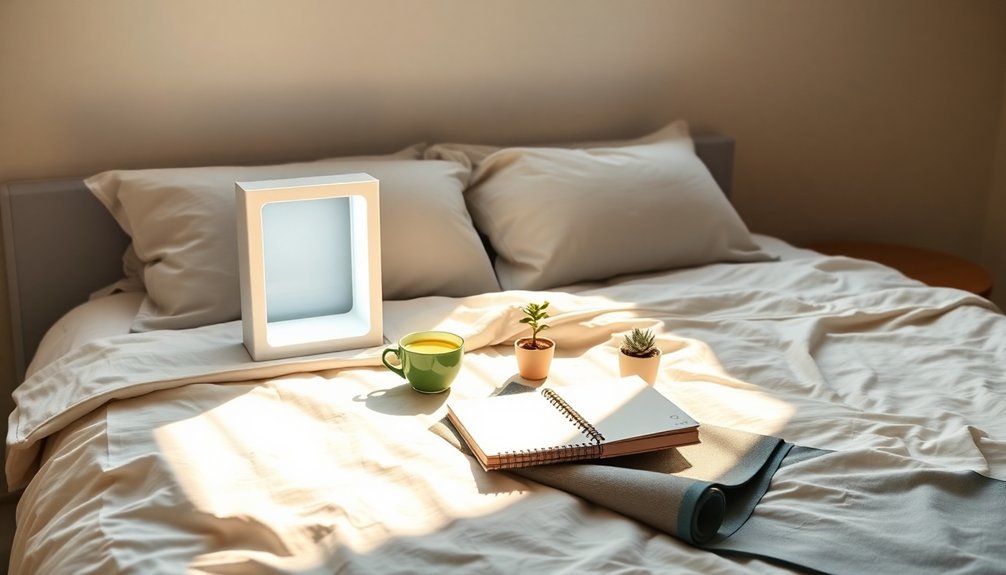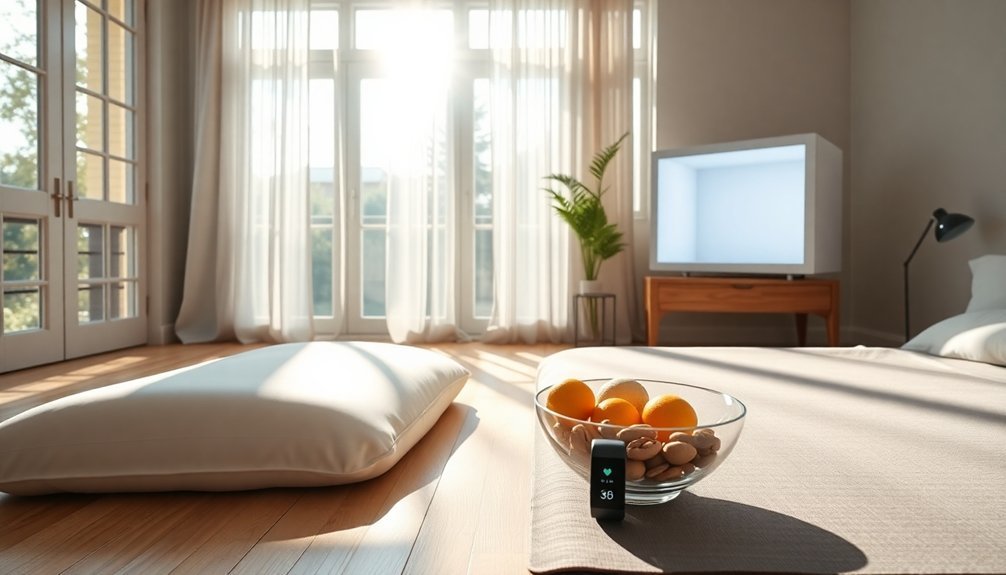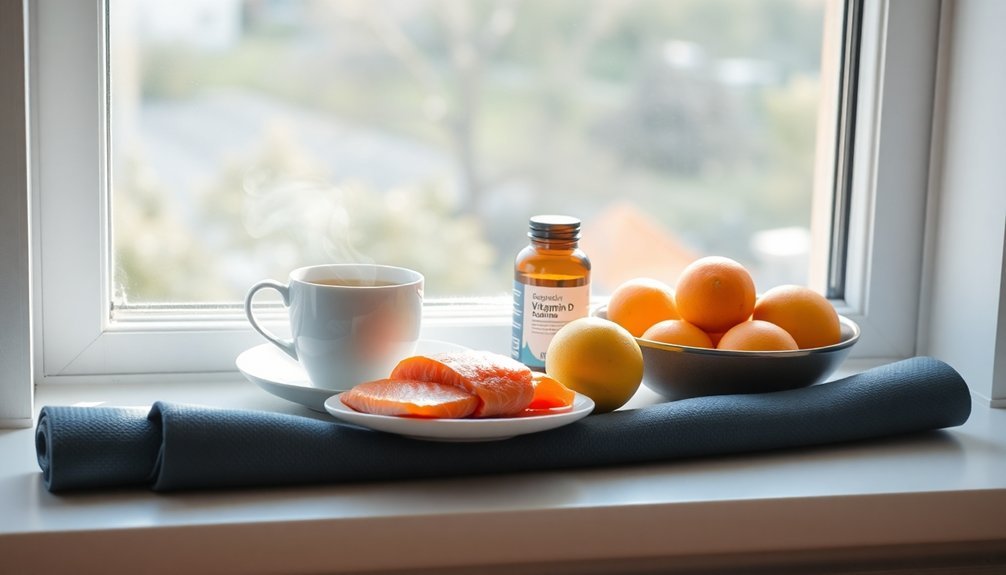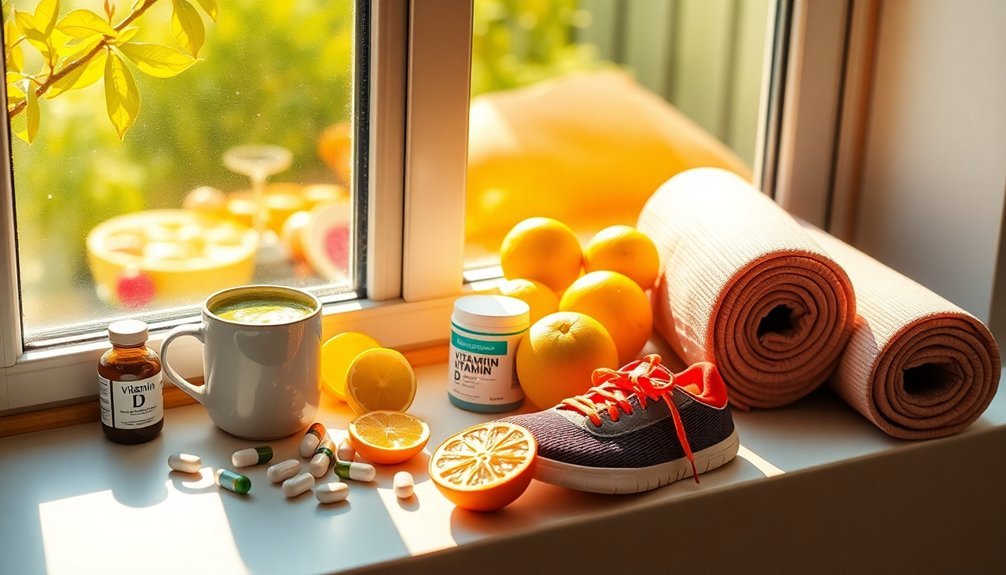Combat seasonal depression's energy drain with these seven proven boosters: Start your day with 30-45 minutes of light box therapy (10,000 lux) to regulate your body's wake cycle. Get outside for morning walks to combine natural sunlight and exercise benefits. Fuel your body with mood-lifting foods like fatty fish, dark chocolate, and complex carbs. Maintain consistent outdoor physical activity, even in winter. Consider vitamin D supplements under medical guidance. Explore professional mental health support for personalized treatment. Take antidepressants if prescribed by your healthcare provider. These science-backed strategies can transform your seasonal slump into sustained essentiality.
Morning Light Box Therapy Routine

While winter's dark mornings can dampen your energy, establishing a consistent light box therapy routine can effectively combat seasonal depression. You'll need a light box that emits 10,000 lux of full-spectrum light, which mimics natural sunlight and helps regulate your body's circadian rhythms.
Start your therapy sessions in early fall, before SAD symptoms emerge. Position yourself 12-24 inches from your light box for 30-45 minutes each morning. You can read, work, or eat breakfast during this time, but don't look directly at the light. Light therapy has shown to be as effective as antidepressants for treating seasonal depression.
For best results, use your light box within the first hour of waking up, as morning exposure is more effective than evening use.
You should notice improvements within a week if you're responding well to the therapy. To maintain benefits, stick to your daily routine until spring arrives.
If you're taking antidepressants, don't stop them – light therapy works well in combination with medication. Remember to consult your healthcare provider before starting, especially if you have eye problems or bipolar disorder. They'll help confirm you're using the therapy safely and effectively.
Natural Sunlight Exposure Schedule
Building on your light box routine, natural sunlight offers even more powerful mood-lifting benefits. During winter months, when exposure drops to just 1.2 hours per day, you'll need to be strategic about getting your sunlight.
Studies show that morning exposure is particularly effective, with 50% of SAD patients experiencing remission after consistent morning walks outdoors. Exercise outdoors can significantly boost your endorphin levels while getting sunlight exposure.
Start your day with a 30-60 minute outdoor session, ideally within the first few hours after waking. You can achieve this through a morning walk, sitting on your porch, or visiting a local park. Even on cloudy days, natural light can boost your mood and regulate your body's internal clock.
If you can't get outside immediately, position yourself near bright windows and keep your curtains open to maximize indoor light exposure.
To increase your daily sunlight intake, consider modifying your environment. Trim any tree branches blocking windows, install skylights if possible, and create bright, sunlit spaces in your home and workplace.
Mood-Boosting Foods

Incorporating mood-boosting foods into your diet can substantially combat seasonal depression symptoms. Focus on fatty fish like salmon and mackerel, which are rich in omega-3s and vitamin D, both essential for improving mood and reducing depression. These fish varieties help enhance nerve signaling in the brain for better cognitive function.
You'll also benefit from including eggs and turkey, which contain tryptophan that helps produce serotonin, your brain's feel-good chemical.
Don't overlook complex carbohydrates and fiber-rich foods. Bananas, oats, and sweet potatoes help stabilize your blood sugar and energy levels throughout the day. They're particularly effective when combined with protein sources like black beans and chickpeas.
For additional mood support, add dark chocolate to your diet – its flavonoids increase calmness and lift spirits.
Include fermented foods like yogurt in your daily routine, as they provide beneficial probiotics that support gut health and mental well-being.
Pumpkin seeds and walnuts offer a powerful combination of tryptophan, magnesium, and omega-3s that can help reduce stress and anxiety.
For an extra boost, start your day with fortified cereals or a cup of coffee, which can help maintain alertness during darker winter months.
Daily Outdoor Exercise Plan
To combat seasonal depression effectively, a well-structured outdoor exercise plan can make a significant difference in your daily energy levels and mood. You'll find that regular outdoor activities boost serotonin levels and regulate sleep patterns, especially when you exercise in the morning sunlight. Research shows that sustained aerobic exercise can significantly improve mood and reduce depressive symptoms.
| Activity | Benefits |
|---|---|
| Morning Walk/Hike | Increases serotonin, improves sleep cycle, connects with nature |
| Snow Sports | Provides vigorous exercise, sunlight exposure, social interaction |
| Outdoor Yoga | Combines mindfulness, physical activity, natural light therapy |
When exercising outdoors during winter, you'll need to prioritize safety. Wear reflective clothing in low-light conditions and choose well-maintained paths or tracks. If weather conditions become too harsh, don't hesitate to switch to indoor alternatives like stationary bikes or treadmills.
For the best results, maintain consistency in your exercise routine. You can adapt your activities seasonally while keeping a regular schedule. Consider joining group activities to enhance social interaction benefits, and combine your exercise plan with other SAD management strategies like light therapy. Remember to consult healthcare professionals for personalized advice, especially if you're new to outdoor winter activities.
Professional Mental Health Support

During periods of seasonal depression, seeking professional mental health support can be crucial for effective treatment and recovery. Mental health professionals can provide personalized treatment plans that combine various therapeutic approaches, including cognitive behavioral therapy (CBT), antidepressants, and light therapy.
You'll find extensive services through organizations like RWJBarnabas Health and specialized clinics such as the Winter Depression Research Clinic at Yale School of Medicine.
When you work with mental health professionals, you can expect:
- A thorough evaluation to determine if you're experiencing SAD or another form of depression
- Evidence-based treatment options tailored to your specific symptoms and needs
- 24/7 support services for crisis intervention and ongoing care
- Regular monitoring of your progress and adjustment of treatment plans as needed
Your provider may recommend a combination of treatments for the best results. If medication is prescribed, SSRIs are often the preferred choice, especially when started at the onset of winter.
While light therapy is popular, you'll want to discuss its effectiveness with your healthcare provider, as evidence supporting its use remains limited according to NICE guidelines.
Vitamin D Optimization
Vitamin D deficiency often lies at the heart of seasonal depression, particularly during winter months when sunlight exposure diminishes. When your vitamin D levels drop, they can disrupt your serotonin and dopamine production, directly impacting your mood and energy levels.
You can boost your vitamin D intake through both dietary sources and lifestyle changes. Include vitamin D-rich foods like salmon, tuna, eggs, and fortified dairy products in your daily meals.
If you're looking for plant-based options, UV-exposed mushrooms and fortified foods can help maintain your levels.
To maximize natural vitamin D production, you'll want to optimize your environment and daily routine. Rearrange your furniture to catch more sunlight through windows, and spend time outdoors, especially during morning hours. Even brief periods of sun exposure can make a difference in your vitamin D levels and mood.
If you're struggling with seasonal depression, consider vitamin D3 supplementation under your healthcare provider's guidance. When combined with light therapy, vitamin D supplements can effectively improve your mood and reduce fatigue, particularly if you have mild seasonal depression symptoms.
Antidepressant Treatment Options

If you're considering antidepressants for seasonal depression, combining them with talk therapy can substantially boost their effectiveness and provide you with coping strategies.
Your doctor may recommend starting SSRIs like fluoxetine or sertraline in early fall, as these medications typically take 2-4 weeks to reach full effectiveness.
You'll want to maintain regular check-ins with your healthcare provider to monitor how well the medication works and adjust the treatment plan as needed.
Combining Medication With Therapy
Today's most effective treatment plans for seasonal depression often combine medication with therapy, creating a thorough approach to symptom management.
When you work with healthcare professionals to develop a personalized treatment strategy, you'll find that combining these approaches can substantially enhance your recovery and prevent future relapses.
The most successful combinations typically include antidepressants like SSRIs or bupropion alongside evidence-based therapies such as CBT or mindfulness-based cognitive therapy.
You'll want to take into account these key benefits of combination therapy:
- You'll experience better symptom control through the dual action of medication managing chemical imbalances while therapy helps you develop coping strategies
- You're less likely to experience relapse since you're learning long-term management skills while getting medical support
- Your treatment can be adjusted more precisely as your healthcare team monitors your progress with both approaches
- You'll develop a broader set of tools to manage your seasonal depression, from medication timing to therapeutic techniques
Remember that your treatment plan should be monitored regularly and adjusted based on your response, ensuring you're getting the most effective combination for your specific needs.
SSRI Timing And Effects
Selective Serotonin Reuptake Inhibitors (SSRIs) play an essential role in managing seasonal affective disorder when properly timed and monitored. You'll typically start taking SSRIs when SAD symptoms first appear in late fall or early winter, with medications like bupropion prescribed for daily use through early spring.
It's vital to understand that these medications take 4-8 weeks to show full effects, so starting early can help prevent symptom recurrence.
SSRIs work by regulating your body's serotonin levels, effectively improving mood and energy levels. Common options include fluoxetine and sertraline, which have shown significant success in treating SAD symptoms. You can use these medications alone or combine them with light therapy for enhanced results.
While they're generally safe and effective, you'll need to obtain a prescription and work closely with your healthcare provider.
Your doctor will monitor your progress through regular follow-ups, adjusting your treatment as needed. Remember, you shouldn't start or stop SSRIs without medical supervision.
If you have a family history of SAD, you might need a more tailored approach, and your healthcare provider can help determine the most effective treatment strategy for your specific situation.
Frequently Asked Questions
How Long Does Seasonal Depression Typically Last Each Year?
You'll typically experience seasonal depression for 4 to 5 months each year, starting around October when daylight hours decrease. Your symptoms may peak in January and February before improving as spring approaches with longer days.
Can Using Artificial Light Boxes Cause Damage to the Eyes?
Yes, artificial light boxes can damage your eyes if used incorrectly. You'll want to follow safety guidelines, avoid looking directly at the light, and stick to recommended exposure times to protect your vision.
What Age Groups Are Most Commonly Affected by Seasonal Depression?
You're most likely to develop seasonal depression between ages 20-30, though it can affect anyone. The condition typically peaks during young adulthood and tends to decrease around age 50, with women being more susceptible.
Does Seasonal Depression Occur in Tropical or Equatorial Regions?
Yes, you can experience seasonal depression in tropical and equatorial regions, though it's less common. In these areas, you're more likely to face summer-pattern SAD, triggered by excessive heat and humidity rather than lack of sunlight.
Can Travel to Sunny Locations Temporarily Cure Seasonal Depression Symptoms?
While traveling to sunny places can temporarily improve your seasonal depression symptoms through increased sunlight exposure, it's not a cure. You'll likely experience symptoms again when you return to areas with less sunlight.
In Summary
You've got powerful tools to fight seasonal depression right at your fingertips. By combining light therapy, outdoor activities, proper nutrition, and professional support, you're taking control of your mental well-being. Don't hesitate to try these energy-boosting strategies and reach out for help when needed. Remember, seasonal depression is treatable, and you're not alone in this journey toward better mental health.





Leave a Reply